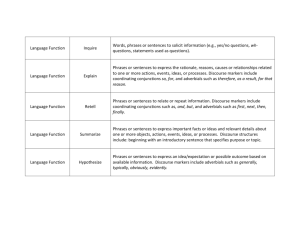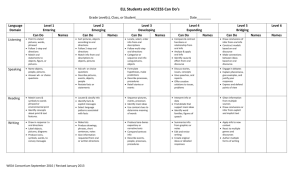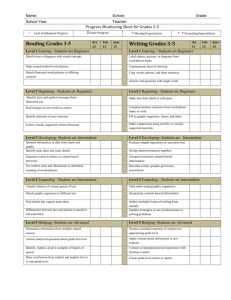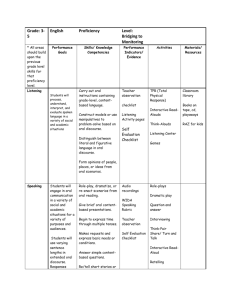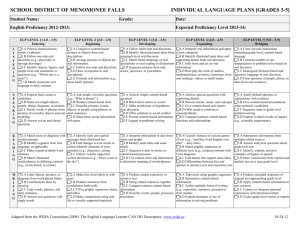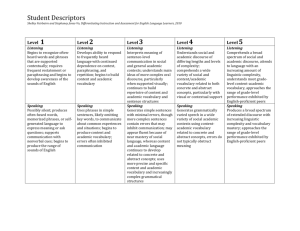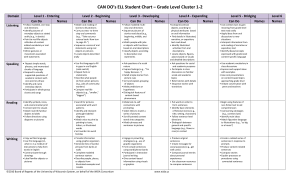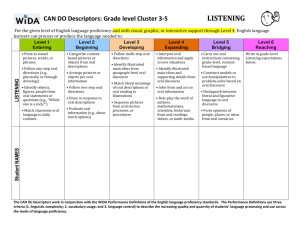full-class-monitor-sheet - Gr3-5 - All Domains - front & back
advertisement
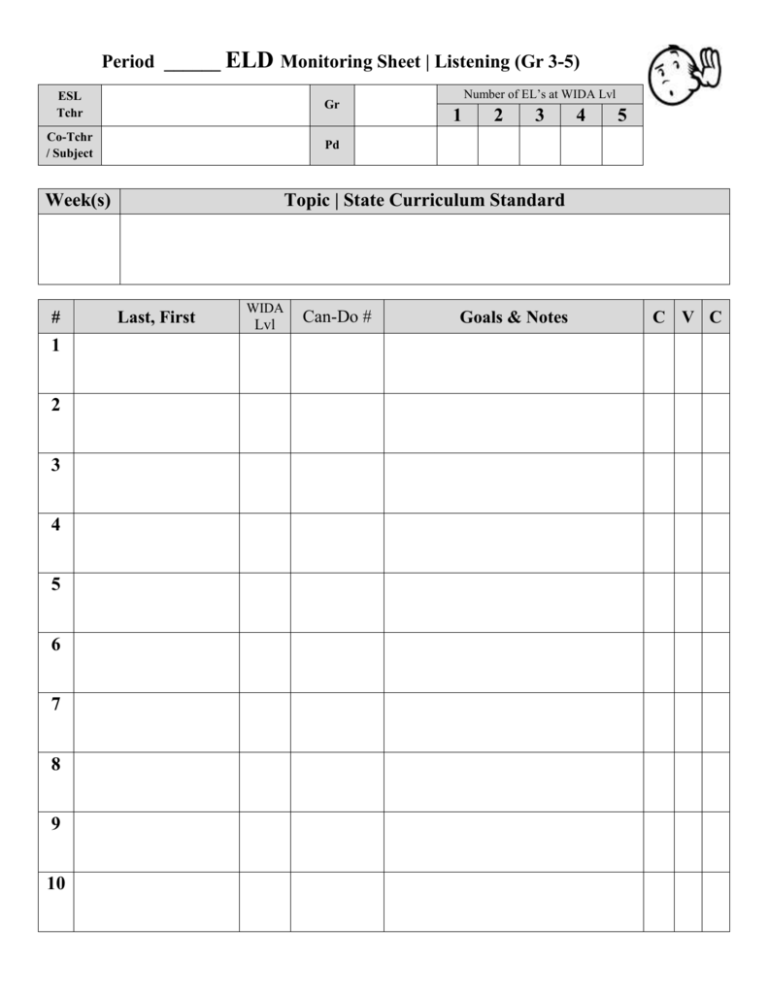
Period ______ ELD Monitoring Sheet | Listening (Gr 3-5) ESL Tchr Gr Co-Tchr / Subject Pd Week(s) # 1 2 3 4 5 6 7 8 9 10 Number of EL’s at WIDA Lvl 1 2 3 4 5 Topic | State Curriculum Standard Last, First WIDA Lvl Can-Do # Goals & Notes C V C REFERENCE SHEET for Listening Class Monitor Sheet (Grs 3-5) “Student-Friendly” & WIDA CAN DO Descriptors: Grade Level Cluster 3-5 For the given level of English language proficiency and with visual, graphic, or interactive support through Level 4, English language learners can process or produce the language needed to: WIDA Listening Student Friendly Listening Level 1: Entering Level 2: Emerging 1.1 Listen and point to pictures or words 2.1 Listen to descriptions and sort pictures. 1.2 Follow one-step directions 2.2 Listen and arrange pictures. 1.3 Listen and find things or people 2.3 Follow two-step directions. 1.4 Listen to the teacher and do the classroom routines. 2.4 Listen and draw pictures. 1.1 Point to stated pictures, words, or phrases 1.2 Follow one-step oral directions (e.g., physically or through drawings) 1.3 Identify objects, figures, people from oral statements or questions (e.g., “Which one is a rock?”) 1.4 Match classroom oral language to daily routines Level 3: Developing 3.1 Follow directions. 3.2 Listen to an explanation and match it to a picture. 3.3 Match descriptions to illustrations. 3.4 Listen to a story and sort pictures. [Listen to an explanation and …] 2.5 Listen to choices and express an opinion. 2.1 Categorize content-based pictures or objects from oral descriptions 2.2 Arrange pictures or objects per oral information 2.3 Follow two-step oral directions 2.4 Draw in response to oral descriptions 2.5 Evaluate oral information (e.g., about lunch options) 3.1 Follow multi-step oral directions 3.2 Identify illustrated main ideas from paragraph-level oral discourse 3.3 Match literal meanings of oral descriptions or oral reading to illustrations 3.4 Sequence pictures from oral stories, processes, or procedures Level 4: Expanding Level 5: Bridging 4.1 Listen to information and apply to a new situation. 5.1 Listen to follow instructions about [math or microscopes or whatever] 4.2 Listen to an explanation and point out details on an illustration. 5.2 [Using a model], listen to a problem and use models to figure it out. 4.3 Listen to [a story, an explanation] 5.3 Listen and explain figurative language. 4.4 Listen about authors [scientists, etc.] and act out what you hear. 5.4 Listen to [stories, explanations] and give opinions. 4.1 Interpret oral information and apply to new situations 4.2 Identify illustrated main ideas and supporting details from oral discourse 4.3 Infer from and act on oral information 4.4 Role play the work of authors, mathematicians, scientists, historians from oral readings, videos, or multimedia 5.1 Carry out oral instructions containing gradelevel, content-based language 5.2 Construct models or use manipulatives to problem-solve based on oral discourse 5.3 Distinguish between literal and figurative language in oral discourse 5.4 Form opinions of people, places, or ideas from oral scenarios CVC Criteria for Performance Definitions Linguistic Complexity: The amount and quality of speech or writing for a given situation Vocabulary Usage: The specificity of words or phrases for a given context Language Control: The comprehensibility of the communication based on the amount and type of errors 1 – Entering 2 – Emerging 3 – Developing 4 – Expanding 5 – Bridging Linguistic Complexity Single words Phrases, short sentences Series of related sentences Moderate discourse Complex discourse Vocabulary Usage Most common vocabulary High frequency vocabulary General and some specific vocabulary Specialized & some technical vocabulary Specialized & technical vocabulary Language Control Memorized language Errors inhibiting communication Meaning overrides errors Language w/minimal errors Language comparable to English peers Period ______ ELD Monitoring Sheet | Speaking (Gr 3-5) ESL Tchr Gr Co-Tchr / Subject Pd Week(s) # 1 2 3 4 5 6 7 8 9 10 Number of EL’s at WIDA Lvl 1 2 3 4 5 Topic | State Curriculum Standard Last, First WIDA Lvl Can-Do # Goals & Notes C V C REFERENCE SHEET for Speaking Class Monitor Sheet (Grs 3-5) “Student-Friendly” & WIDA CAN DO Descriptors: Grade Level Cluster 3-5 For the given level of English language proficiency and with visual, graphic, or interactive support through Level 4, English language learners can process or produce the language needed to: WIDA Speaking Student Friendly Speaking Level 1: Entering 1.1 Tell what you need. Tell how you feel. 1.2 Say the names of things. 1.3 Repeat words and phrases from pictures. 1.4 Answer yes/no questions. Answer choice questions. 1.1 Express basic needs or conditions 1.2 Name pre-taught objects, people, diagrams, or pictures 1.3 Recite words or phrases from pictures of everyday objects and oral modeling 1.4 Answer yes/no and choice questions Level 2: Emerging Level 3: Developing Level 4: Expanding 2.1 Ask everyday questions. 3. 1 Answer simple questions about [school subjects] 4.1 Give reasons for an opinion. 5.1 Use evidence to defend opinions. 2.2 Restate facts about school topics. 3.2 Re-tell stories/events. 4.2 Discuss stories, issues and concepts. 5.2 Give oral presentations using technical vocabulary. 2.3 Describe [people, events, objects, or people]. 2.4 Talk about yourself with other students. 3.3 Listen to [stories, explanations] and make predictions 3.4 Listen to [stories, explanations] and guess why things happened. 3.5 Offer solutions to social conflicts. 3.6 Make presentations. 3. Solve problems. 4.3 Give oral reports. 4.4 Compare solutions to a problem. 4.5 Compare and contrast [ideas from a subject]. 2.1 Ask simple, everyday questions (e.g., “Who is absent?”) 3.1 Answer simple content-based questions 2.2 Restate contentbased facts 3.3 Make predictions from discourse 4.2 Discuss stories, issues, and concepts 2.3 Describe pictures, events, objects, or people using phrases or short sentences 3.4 Make hypotheses from discourse. 4.3 Give contentbased oral reports 3.5 Offer solutions to social conflict 4.4 Offer creative solutions to issues/problems 2.4 Share basic social information with peers 3.2 Re/tell short stories or events 3.6 Present content-based information 3.u Engage in problem-solving 4.1 Answer opinion questions with supporting details 4.5 Compare/contrast content-based functions and relationships Level 5: Bridging 5.3 List the steps you take to solve a problem. 5.4 Explain the results of an experiment. 5.1 Justify/defend opinions or explanations with evidence 5.2 Give content-based presentations using technical vocabulary 5.3 Sequence steps in grade-level problemsolving 5.4 Explain in detail results of inquiry (e.g., scientific experiments) CVC Criteria for Performance Definitions Linguistic Complexity: The amount and quality of speech or writing for a given situation Vocabulary Usage: The specificity of words or phrases for a given context Language Control: The comprehensibility of the communication based on the amount and type of errors 1 – Entering 2 – Emerging 3 – Developing 4 – Expanding 5 – Bridging Linguistic Complexity Single words Phrases, short sentences Series of related sentences Moderate discourse Complex discourse Vocabulary Usage Most common vocabulary High frequency vocabulary General and some specific vocabulary Specialized & some technical vocabulary Specialized & technical vocabulary Language Control Memorized language Errors inhibiting communication Meaning overrides errors Language w/minimal errors Language comparable to English peers Period ______ ELD Monitoring Sheet | Reading (Gr 3-5) ESL Tchr Gr Co-Tchr / Subject Pd Week(s) # 1 2 3 4 5 6 7 8 9 10 Number of EL’s at WIDA Lvl 1 2 3 4 5 Topic | State Curriculum Standard Last, First WIDA Lvl Can-Do # Goals & Notes C V C REFERENCE SHEET for Reading Class Monitor Sheet (Grs 3-5) “Student-Friendly” & WIDA CAN DO Descriptors: Grade Level Cluster 3-5 For the given level of English language proficiency and with visual, graphic, or interactive support through Level 4, English language learners can process or produce the language needed to: WIDA Reading Student Friendly Reading Level 1: Entering 1.1 Match symbols to words [or concepts] 1.2 Identify cognates. 1.3 Make sound/symbol/wor d relations 1.4 Match words on the board to words and pictures. Level 2: Emerging 2.1 Read texts with illustrations and identify facts and ideas. 2.2 Find changes to root words in sentences or stories. 2.3 Identify elements of stories [characters, setting, etc.] Level 3: Developing Level 4: Expanding 3.1 Interpret data from charts and graphs. 4.1 Classify features of genres. 3.2 Identify main ideas and some details. 4.2 Choose the graphic organizer that matches a text. 3.3 Sequence events in stories [articles, explanations, historical accounts]. 4.3 Find details that support main ideas. 3.4 Use context clues and illustrations to figure out the meaning of words or phrases. 4.4 Distinguish fact and opinion. 3.1 Interpret information or data from charts and graphs 3.2 Identify main ideas and some details 3.3 Sequence events in stories or content-based processes 3.4 Use context clues and illustrations to determine meaning of words/phrases 4.1 Classify features of various genres of text (e.g., “and they lived happily ever after”— fairy tales) 4.2 Match graphic organizers to different texts (e.g., compare/ contrast with Venn diagram) 4.3 Find details that support main ideas 4.4 Differentiate between fact and opinion in narrative and expository text Level 5: Bridging 5.1 Summarize information from [#] sources. 5.2 Answer thought questions. 5.3 Identify and explain examples of figures of speech. [Give examples of figures of speech.] 5.4 Make inferences. 2.4 Follow written directions. (visually supported) 1.1 Match icons or diagrams with words/concepts 1.2 Identify cognates from first language, as applicable 1.3 Make sound/ symbol/ word relations 1.4 Match illustrated words/ phrases in differing contexts (e.g., on the board, in a book) 2.1 Identify facts and explicit messages from illustrated text 2.2 Find changes to root words in context 2.3 Identify elements of story grammar (e.g., characters, setting) 2.4 Follow visually supported written directions (e.g., “Draw a star in the sky.”) 5.1 Summarize information from multiple related sources 5.2 Answer analytical questions about grade-level text 5.3 Identify, explain, and give examples of figures of speech 5.4 Draw conclusions from explicit and implicit text at or near grade level CVC Criteria for Performance Definitions Linguistic Complexity: The amount and quality of speech or writing for a given situation Vocabulary Usage: The specificity of words or phrases for a given context Language Control: The comprehensibility of the communication based on the amount and type of errors 1 – Entering 2 – Emerging 3 – Developing 4 – Expanding 5 – Bridging Linguistic Complexity Single words Phrases, short sentences Series of related sentences Moderate discourse Complex discourse Vocabulary Usage Most common vocabulary High frequency vocabulary General and some specific vocabulary Specialized & some technical vocabulary Specialized & technical vocabulary Language Control Memorized language Errors inhibiting communication Meaning overrides errors Language w/minimal errors Language comparable to English peers Period ______ ELD Monitoring Sheet | Writing (Gr 3-5) ESL Tchr Gr Co-Tchr / Subject Pd Week(s) # 1 2 3 4 5 6 7 8 9 10 Number of EL’s at WIDA Lvl 1 2 3 4 5 Topic | State Curriculum Standard Last, First WIDA Lvl Can-Do # Goals & Notes C V C REFERENCE SHEET for Writing Class Monitor Sheet (Grs 3-5) “Student-Friendly” & WIDA CAN DO Descriptors: Grade Level Cluster 3-5 For the given level of English language proficiency and with visual, graphic, or interactive support through Level 4, English language learners can process or produce the language needed to: WIDA Speaking Student Friendly Speaking Level 1: Entering Level 2: Emerging 1.1 Write the words that tell about things 2.1 Make lists from labels or with other students 1.2 Tell what I think by drawing 2.2 Finish or write sentences using word walls 1.3 Copy words and short sentences 1.4 Answer questions with one word 2.3 Fill in graphic organizers, charts, and tables Level 3: Developing 3.1 Write stories or reports 3.2 Write sentences that go together 3.3 Write what is the same and different about two sets of information 3.4 Write about things or people or ways to do something 2.1 Make lists from labels or with peers 2.2 Complete/produce sentences from word/ phrase banks or walls 2.3 Fill in graphic organizers, charts, and tables 2.4 Make comparisons using real-life or visuallysupported materials 3.1 Produce simple expository or narrative text 3.2 String related sentences together 3.3 Compare/contrast contentbased information 3.4 Describe events, people, processes, procedures Level 5: Bridging 4.1 Use graphic organizer to take notes 5.1 Write responses to texts near my grade level 4.2 Summarize information about a subject 5.2 Write about [new situation] using information I learned in class 4.3 Write different kinds of texts 4.4 Tell how I solved a problem 2.4 Write a comparison about [some realia] 1.1 Label objects, pictures, or diagrams from word/phrase banks 1.2 Communicate ideas by drawing 1.3 Copy words, phrases, and short sentences 1.4 Answer oral questions with single words Level 4: Expanding 4.1 Take notes using graphic organizers 4.2 Summarize content-based information 4.3 Author multiple forms of writing (e.g., expository, narrative, persuasive) from models 4.4 Explain strategies or use of information in solving problems 5.3 Make text-to-self connections 5.4 Write stories or reports 5.1 Produce extended responses of original text approaching grade level 5.2 Apply contentbased information to new contexts 5.3 Connect or integrate personal experiences with literature/content 5.4 Create grade-level stories or reports CVC Criteria for Performance Definitions Linguistic Complexity: The amount and quality of speech or writing for a given situation Vocabulary Usage: The specificity of words or phrases for a given context Language Control: The comprehensibility of the communication based on the amount and type of errors 1 – Entering 2 – Emerging 3 – Developing 4 – Expanding 5 – Bridging Linguistic Complexity Single words Phrases, short sentences Series of related sentences Moderate discourse Complex discourse Vocabulary Usage Most common vocabulary High frequency vocabulary General and some specific vocabulary Specialized & some technical vocabulary Specialized & technical vocabulary Language Control Memorized language Errors inhibiting communication Meaning overrides errors Language w/minimal errors Language comparable to English peers
